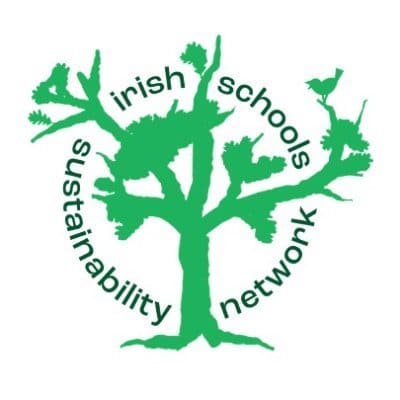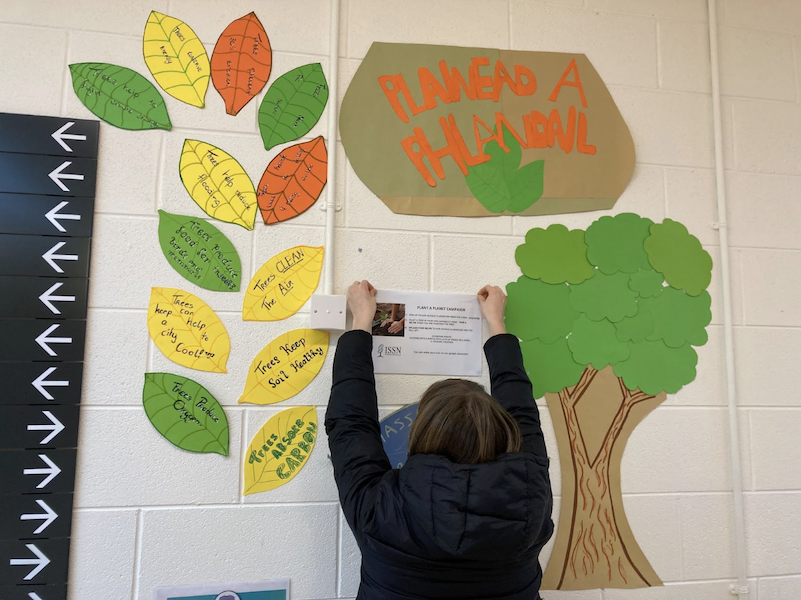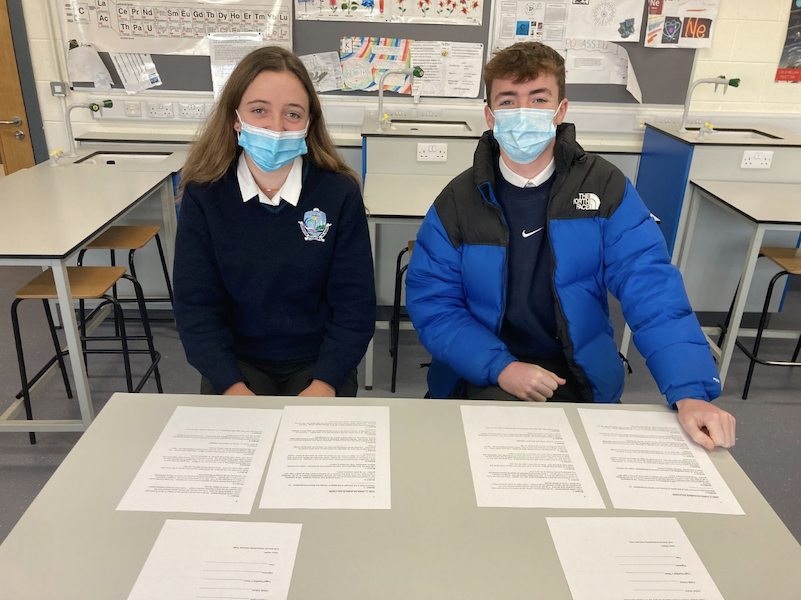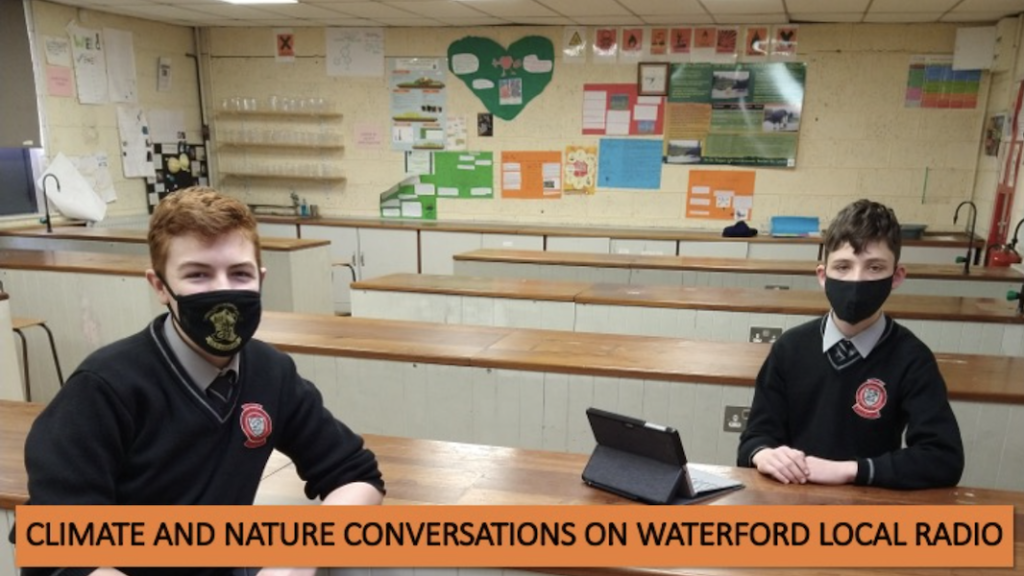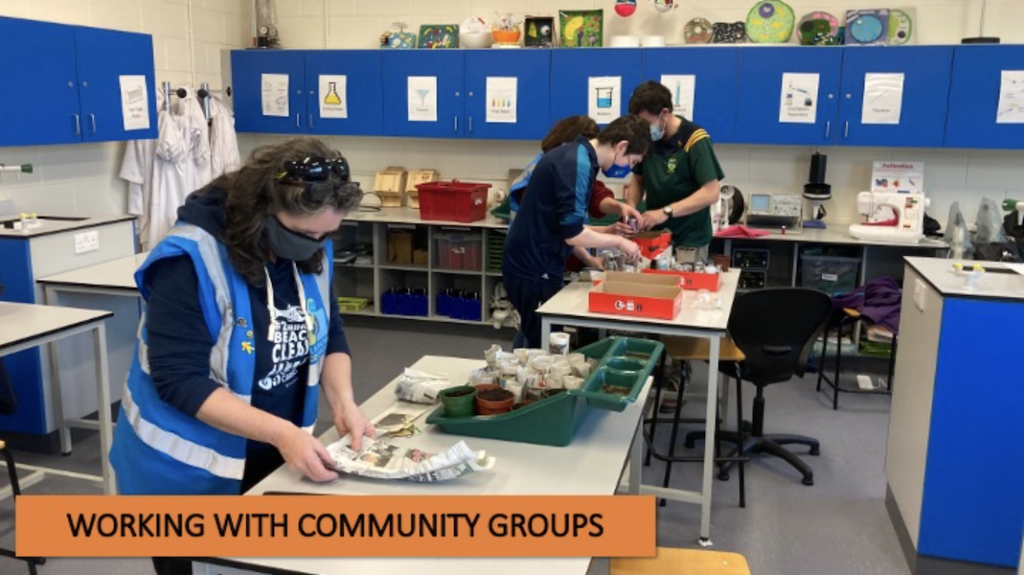Inspiring to “revolutionise” climate change and nature education.
Co Waterford teacher has sounded a clarion call for schools to join a network aiming to “revolutionise” climate change education in the classroom.
Full article here: School network aims to ‘revolutionise’ climate change and nature education
“By working together we might be able to change the education system.”
Irish Schools Sustainability Network
The ISSN was founded in March ’21 to provide a forum for teachers and students to work in partnership to accelerate climate action, address the loss of nature, and prioritise sustainability in the Irish Education System.
We work on joint initiatives and campaigns highlighting the power of partnerships and networking. We develop partnerships with local and national organisations, charities, & groups to push sustainability up the agenda. We generate enthusiasm and inspire each other to take action by highlighting and sharing best practice in sustainability.
We believe that education is about preparing our students for the future. Climate and nature education should be woven into the fabric of school life from primary through to secondary school.
Our mission is to reimagine our education system and foster a culture of agency and empowerment steering away from a culture of apathy and acceptance. Working together we can create a community that see nature as something with its own inherent value rather than a resource to be exploited. Education should inspire critical thinking and active democracy ensuring that everyone feels that they have a role in shaping a better future.
If we are to succeed we need everyone on board.
Taking a Leap of Faith
by Matthew Murray, 6th year student in Ardscoil na Mara, Co. Waterford
It was around this time last year when I was in 5th year when my name got thrown down for an eco-story telling workshop by my biology teacher. I initially thought this could be an excuse to get a break from the books! Little did I know this was the start of something very special for me.
When I was first told I had to make my own three or four minute video my initial thoughts were ‘I can’t do that’. After going to my first workshop I was contemplating should I even bother going again? Although the task seemed difficult I wanted to prove to myself that I could do something that was beyond my current skill set. I learned that sometimes you need to take ‘a leap of faith’ to see yourself grow as an individual. Thankfully my leap of faith paid off and the video I made from the workshop ended up being played at the Oxford Museum of Natural History during COP26! From this project I learnt many valuable skills such as video editing, time management and communication which will help me be equipped for college life. It was very rewarding to make a video that will be on Youtube forever.
Although this was a project I knew I didn’t have to do and that there were no consequences if I didn’t do it, I knew I had an opportunity to challenge myself. When you challenge yourself you step outside your comfort zone. At the end of the day, regardless of whether or not you enjoyed your specific challenge, you have still grown as an individual (this is very important to remember). Many are used to sticking to routine and thus playing it safe but when you take that ‘leap of faith’ you have an opportunity to exponentially grow as a human being and excel in the long run.
I have since been involved with various eco projects/eco networks such as the Irish Schools Sustainability Network, Young Environmentalist Award and the Climate Ambassador Program. As a 6th year student it was challenging to manage my studies and all of these other projects at the same time but it was quite rewarding to see myself grow as an individual within the space of a year. I’ve seen some of my daily habits change. I try to spend as much time in nature as I can rather than being on my phone all the time. From being involved in these projects and networks I’ve developed my leadership, communication, and public speaking skills. My confidence and drive has increased and I am more open-minded. I’m very grateful for all of these opportunities I’ve had which all lead back to the sustainability committee.
I was very proud to take part in the Plant a Planet campaign (a tree planting initiative by the Irish Schools Sustainability Network). It was very rewarding to see over 1600 trees planted across Ireland. It was a very good feeling knowing that you helped so many people to connect with nature and to give them an opportunity to take climate action. I also got to meet some inspiring people who have changed how I see things. Since I got involved with the sustainability committee I got to grow my own network. This is a valuable asset I will have going into college in September. I’m very proud and excited that I have all of these skills and connections going into the adult world, after all it’s about who you know, not what you know!
My advice to anyone who is on a border line of deciding to do something or not can be summarized in one line.
The biggest risks in life are the ones that you don’t take.
The Most Beautiful Light In History
by Niamh Purcell, student, Ardscoil na Mara, Co. Waterford
I’m just a Waterford girl. I have just one voice. Just one message. I am just one light in a sea of darkness. I am just one believer in hope. And this is my message for you to join me in the fight for change.
For decades, the climate crisis, and twin biodiversity crisis, have been slowly worsening. Popular belief says that this is the worst crisis that humanity has ever faced – opposing belief says the crisis doesn’t exist. These conflicting (and often contradictory) statements could be the leading reason that action – proper, effective action – has not been taken to stop these crises. The truth of the matter is that the climate crisis is, very possibly, the most catastrophic issue humankind, and our planet, has ever experienced. It will not be combated by being ignored, nor by being met with scepticism. It can only – and will only – be combated by action, belief, and faith in the everlasting righteousness of the human spirit.
My own journey through climate action has not been easy. The first time I heard about the crisis was in 2018, shortly after the Australian Bush Fires of that year began to be reported. I got online to research this new term, “climate change” – and what I found truly shocked me, to my core. I learned of the millions of people who are suffering due to climate droughts, and more severe weather events, everywhere around the world. People just like you and I. I learned of the Paris Climate Agreement, drawn up and signed by world leaders in 2015. And at this time, I was young, so my innocence allowed me to believe that the commitments laid out by this agreement would be enough to save our home. So I did nothing.
In 2020, when Ireland missed the targets set by that very agreement, I was nothing short of outraged! This agreement had been drawn up to help save our planet – why was it being ignored so easily? Almost as though it had never existed. It became clear to me, very quickly, that ordinary people would be the ones to rectify this horrible situation. This realisation sparked a very small amount of action in me, and I began writing to TDs and Government Ministers, begging them to take action to stop this horrible mess. But I never heard any response. While young, I was no longer stupid. No longer blinded. No longer innocent. I felt… hopeless.
A year and a half later, during the summer of 2021, I was asked to participate in a series of Climate and Nature Conversations that would be run on my local radio station. The conversations were being held by my school’s Sustainability Group, and here I met a wonderful teacher in my school, Dr. Patrick Kirwan, who quickly became a mentor and friend. I was never supposed to be a permanent member of the Sustainability Group. But I found that, once I had started talking about the crisis that had mattered to me for so long… I didn’t feel so hopeless anymore. And I didn’t want to stop. I had found my voice, and I wanted to shout out my message for everyone to hear. So I did.
Since then, I have set up and lead a number of sustainability initiatives, including lobbying my school’s cafeteria to use cutlery made from wood instead of plastic, helping to write up an Environmental Influencer Course (which is being taught in my school today), and I have taught this course to classes in my school myself. But the most important project I have been involved in was our tree planting initiative.
Our tree planting initiative was called Phláinéad a Plaintáil (Plant A Planet), and was a collaborative collective action taken by a number of schools across the country. It was run as part of a network called the ISSN (Irish Schools Sustainability Network). The ISSN is a network that is dedicated to promoting climate awareness, education and action in schools, and does so by bringing people from different schools across Ireland together. What made this campaign different was that, instead of planting trees on the school grounds, we had our students plant a tree at home. It was also an educational project, informing people in both our school and wider communities about the climate and biodiversity and crises, and how they can help to stop them from escalating. Four of the schools that participated in the Plant A Planet have been put forward to win a Young Environmentalist Award (YEA). These four schools planted over 900 trees between them, with each school reaching higher than the set target of 10% of the schools population planting a tree at home. My own school had 15% of the school population plant a tree. While taking such a massive collective action, the students involved also made strong friendships that they have continued outside of the network.
If you asked me what I think the biggest problem associated with climate change is, I would tell you it is lack of education. We all know what the consequences of climate change are. We know about the travesties of the past. We know of the challenges yet to come. We could list off all of the challenges, all of the problems, all of the ways that this terrible crisis affects us – but how many solutions can we describe? We are at that awkward place where we could list all of the problems backwards, but we don’t know any – or many – of the solutions. And that makes us feel too small, too insignificant, too powerless, to be able to change this. And this is due to lack of education. But when we’re educated, we know both the problems and the solutions. And when we know the solutions to the problem, and the challenge that climate change might throw at us, we can feel empowered enough to change it. And empowerment is the key.
On our own, we are all just one person. No one on the entire planet could feel able to solve this on their own. But together, we are billions. Billions of voices. Billions of symbols of hope. Billions of lights in this time of darkness. And we can all stand as one. We can shout out the same message, promote the same symbol, be the most blinding, beautiful light ever seen in history. And we all have a voice. We all have a message. We can all get our point across. I know this seems terrifying, and this mountain may seem insurmountable. But we CAN combat these crises. We CAN change this. Maybe we still have a chance at completely rectifying it. But, if that chance still exists, it won’t be around for much longer. The sad truth is that we will never know when our last chance to fix this will slip away. We will never know when time will run out. It could be next year. It could be tomorrow. It could be right now, as you’re reading this article. And that is probably the most terrifying thing about it all. But it should also be the reason that we start to take long-lasting, effective action, right now.
For a very long time, it has been evident that we cannot continue as we had in the past. For a very long time, the Earth has been crying out for help. For change. Now, we have to listen to those cries. It was easier to turn a blind eye… of course it was easier. But we can’t do that now. The time has come for us to use our voices. The time has come for us to change what is wrong. And we can do it! We can most definitely do it. We just have to have faith. We just have to be strong. We just have to know that fixing it will take some time, but every second of the struggle will be worth it in the end. We have a long way to go. And I’m not saying it will be easy – it won’t be easy. But if we start making changes today, we might just have a better tomorrow. Because it’s not just the planet we’re talking about anymore – it’s our home.
As part of the Irish Schools Sustainability Network Students in Ardscoil na Mara, Edmund Rice Secondary School, Rockbrook Park School, and Gairmscoil Mhic Diarmada worked together on the Plant a Planet Campaign. Students were delighted to win their category of Eco-Health and Wellbeing in ECOUNESCO’S Young Environmentalist Award competition. They came together in collective action to address climate change and the loss of nature. Their aim, which they achieved, was to get 10% of staff and students in our schools to plant a tree in their own garden. They wanted students to get active in their own home and reimagine their own garden spaces and have climate and nature conversations with their own families.
They taught students in their school how to plant a tree and provided information on what native trees are good to plant in small, medium and large gardens. They raised awareness in their schools and wider community that planting a tree is good for addressing climate change, improving biodiversity, helping with improving soil and alleviating flooding, as well as improving our own wellbeing. They also ran a school wide information campaign involving posters, tannoy announcements, workshops, lessons, parent emails and surveys. They wrote articles in local newspapers, ran a climate and nature conversation series on a local radio station and connected with local businesses and community groups.
This was a great achievement and it is wonderful to see friendships forming between students in different schools.
It’s time to start rewilding our education system
by Codie Preston
Teacher, Rockbrook Park School & ISSN.
A couple of years ago, after arriving early to school one morning, I was surprised to see a heron at our school pond. It is a small pond that herons do not visit often so it attracted attention from the students. Later that day our groundskeeper called to me with a wry grin, ‘Mr. Preston, you should be sacked!’. What had I done this time?, I wondered. He proceeded to tell me that he had overheard one of my 6th year biology students telling his pal that he saw a SWAN at the pond that morning! We laughed. But it revealed to me one of the big issues we have in education and in Irish society, that so many people have little or no connection to, or knowledge of, wildlife whatsoever.
I subsequently investigated this anecdotally by showing my classes pictures of the most common Irish birds to find that only a very small few know the difference between a crow and a blackbird, know the name of a sparrow or recognise a wren. At first I was shocked but I couldn’t be surprised. How could we know the names of plants and animals unless we have learnt them from somebody else?
I am a thirty-something year old teacher and even within my lifetime I have seen a massive decline in nature. As a child I was fascinated with wildlife, an interest I certainly got from my father. I would regularly be seen with an empty jam jar, wandering from garden to garden in our housing estate, catching bees and wasps and beetles. I remember the gardens humming with bees and I would put the jam jar up to my ear and be fascinated by the amplified buzzing that came from inside.
We used to spend warm days squashing ‘blood-suckers’ that would be crawling all over the garden walls and sometimes, I’m not proud to say, using magnifying glasses to burn them. We threw ‘stickybacks’ onto each other’s clothes, threatened one another with ‘wet-the-beds’, made wishes by blowing ‘jinny-joes’ and tested if our friends liked butter by holding buttercups under their chins and seeing if it turned yellow.
I spent hours watching the greenfinches and chaffinches in the garden, and I had a little pocket guide to Irish birds and tested myself regularly to make sure I knew their names.
On a school service trip to Kenya a few years ago I was brought right back to my childhood when I passed a young boy who was playing what looked like some type of mechanical flying toy. It was attached to a string and was circling his head. I stopped to enquire about what it was to find it was a large flying beetle that he had on a lead. Everytime the beetle tried to escape, the string forced it to fly in centrifugal motion, bringing great joy to the little boy.
Whilst using magnifying glasses to burn clover mites and keeping beetles on a lead are certainly not to be encouraged, they are both a result of time spent with nature, moments of curiosity and discovery. They are part of a child growing up and learning about the world around them.
Today, I still have the same interest in wildlife but I see much less of it. The bushes are void of bees, the bloodsuckers have all but disappeared and a sighting of a greenfinch for me is now as rare as a hen’s tooth. In my job as a biology teacher I take my students outside whenever I can, but even though our school has large grounds with a number of habitats, it can sometimes be hard to find the birds and the bees that you would like to talk about.
It’s not just my anecdotal observations that say that wildlife is declining. A massive UN report from the Intergovernmental Science-Policy Platform on Biodiversity and Ecosystem Services (IPBES) in 2019 found that ‘Nature is declining globally at rates unprecedented in human history – and the rate of species extinctions is accelerating, with grave impacts on people around the world now likely’.
Compiled by 145 expert authors from 50 countries over three years, the report assesses changes over the past five decades, providing a comprehensive picture of the relationship between economic development pathways and their impacts on nature.
The figures are terrifying:
- 75% of terrestrial environments “severely altered” to date by human actions (marine environments 66%).
- +/-60 billion tons of renewable and non-renewable resources extracted globally each year, up nearly 100% since 1980.
- >85% of wetlands present in 1700 had been lost by 2000 – loss of wetlands is currently three times faster, in percentage terms, than forest loss.
- Up to 1 million species threatened with extinction, many within decades.
The UK’s flying insect population has declined by as much as 60% in the last 20 years, a new study has revealed. In Ireland, recent biodiversity audits paint a worrying portrait, with a quarter of birds a serious conservation concern, 77 species of plants and animals considered endangered and only five of 59 habitat types in a favourable condition (https://www.thejournal.ie/endangered-species-part-1-5520770-Aug2021/).
So what can we do?
The school in which I work, Rockbrook Park School, is located in the Dublin Mountains and has beautiful grounds with a river, small wooded area and some grasslands that we allow to grow wild. It is the perfect place to learn about wildlife and in recent years we have been trying to make use of that by developing a nature trail consisting of 10 information signs on the different habitats and species found around the grounds. We have a fantastic green school committee who put the ideas into action. We now invite primary school students to our school to take part in nature activities and use our nature room. This year we ran our first ever Biodiversity festival, a series of walks and talks from passionate local volunteers, to share the wonder and beauty of nature with families and the public. It was a great success
We also became part of the Irish Schools Sustainability Network (ISSN). This has been hugely beneficial to us as connecting with other like minded teachers and students inspires us to keep taking actions to make our schools and communities more sustainable places. Students and teachers from different parts of Ireland meet once a month online to share ideas and actions. We also ran a collaborative campaign called Plant a Planet where schools sourced and sold native Irish trees in their communities and together over 1000 trees have been planted in gardens around the country.
The students connected online throughout the project but got the opportunity to meet in person this month and it was heartwarming to see how well they instantly got on, chatting and laughing as if they knew each other for years. Their efforts on the Plant a Planet campaign were rewarded when they were named winners of the Eco-health and Wellbeing category at the Eco Unesco Young Environmentalist Awards 2022.
We are lucky to have such inspiring students and teachers in our schools but the vast majority are not yet activated about the urgent threats facing our planet, and they won’t be until they know what they are losing. The education system has to change to allow students to create real connections with nature, learn the names of plants, animals and insects and understand the connectedness of biodiversity and the existential threat of climate catastrophe.
Knowing the name of something or someone is incredibly powerful and changes the way we view and treat them. Farmers and their families avoid giving their farm animals names because once a goat or a sheep has a name it is much harder to kill it. As a new father the first question anyone asks when they see our son is of course, ‘What’s his name?’. Knowing the names of plants, insects and other animals is the fundamental first step in getting people to want to protect them.
One bird most of my students did know was the Robin. Robins are famous, probably due to their association with Christmas, as well as being very common in Irish gardens. There are many superstitions around Robins. Some say that they are a reincarnation of a loved one who has passed away while others think they are a sign of a tragedy to come. Either way, it is this cultural connection between the person and the bird that makes the Robin one of our most loved and protected wild birds.
My students look at me blankly or laugh when I mention things like jinnyjoes or sticky backs. They struggle to distinguish between a bee and a wasp. It’s not their fault, the generations before them have failed to pass on the joys of nature, the names of birds, the fun of catching bugs and making daisy chains. True nature education is not learned from books or in classrooms, it’s discovered outside, digging holes and upturning rocks and just sitting still in the grass.
Many of us have lost our connection to nature, maybe in part because we have gained stronger connections to the devices in our pockets. Nature is now something abstract that we watch on TV and on youtube instead of experiencing it in real life. It did my heart good to see that that little boy in Kenya hadn’t lost that connection just yet.
Reversing species loss and restoring habitats may be easier than we think. Nature has an amazing ability to bounce back when left alone but humans have to let go of the land, something often referred to as rewilding. Restoring nature will also require rewilding people, starting with ourselves and then the people around us.
It’s time to start rewilding our education system too, by training teachers to deliver basic nature education, funding in outdoor educational spaces and protecting areas for the benefit of wildlife. Lets create a revolution in education that puts nature and sustainability at the heart of what we teach our students. Let’s make sure the living planet we leave to our young people will be a wilder and more sustainable one than the one we have right now.
Rockbrook Park School, Dublin 16
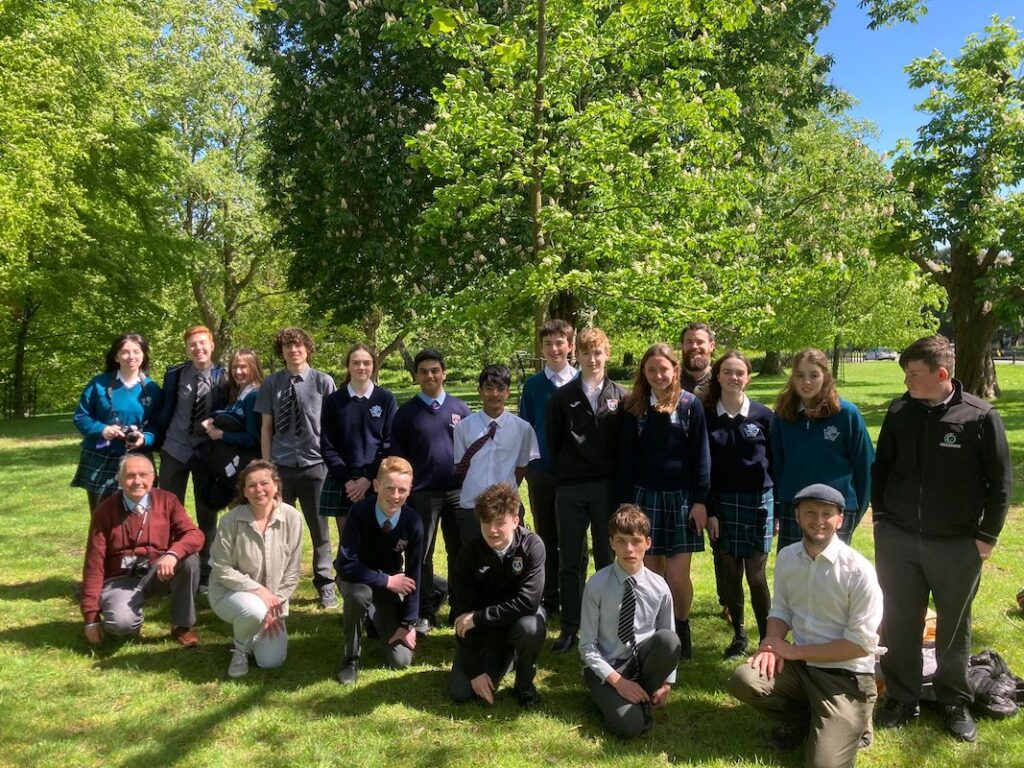
Students and teachers from Rockbrook (Dublin), Belvedere Col (Dublin), Ard Scoil na Mara (Waterford), Edmond Rice SS (Tipperary)
